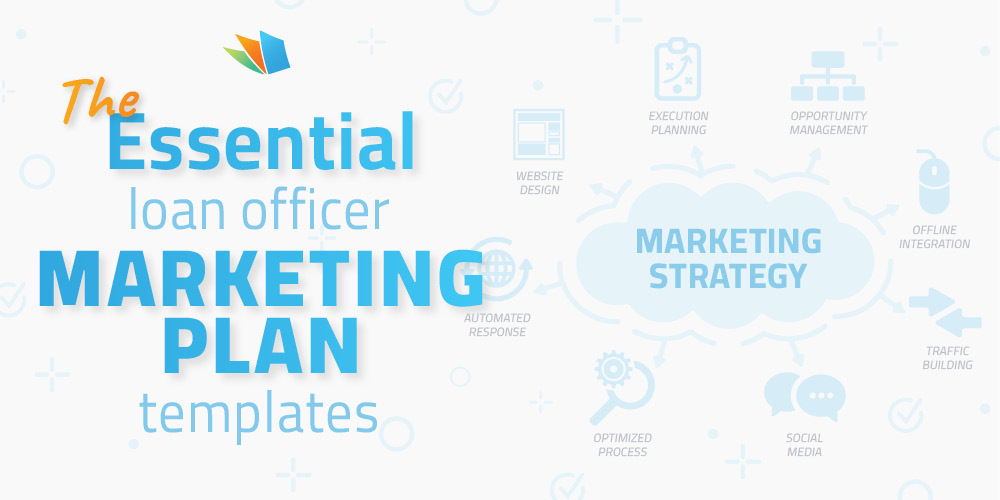
A marketing plan helps you grow your mortgage business – this is true even for single MLO’s. But let’s face it, creating a plan can be overwhelming and confusing. We understand. Many loan officers find themselves in the same boat.
The great news is that we’ve simplified it for you with this guide.
Our straightforward but thorough loan officer marketing plan template covers everything you need to succeed in your role and ensure business growth. With our help, you can stop stressing about creating a plan and start focusing on reaching your goals toward mortgage business success.
Invest in Your Success – Schedule a Demo
Identifying Where Your Business Currently Stands
Prospecting likely takes up the majority of your day, but you don’t want to overlook analyzing your business as a whole. For example, are you keenly aware of which marketing activities are bringing in business or whether there were any significant changes to your lead generation avenues?
Start by focusing on where your leads are currently coming from and where they drop off. For example, if you see that you’re getting traffic from social media, but you struggle to move them further down the path to closing, you know that there’s work to be done there.
Note that little to no leads from a particular source doesn’t mean you should abandon it altogether. For example, you may have heard that email marketing is dead, but that’s simply not true.
Email marketing has some of the highest ROI’s as well as decent conversion rates in marketing. So if one of your lead generation tactics isn’t quite panning out, it may just mean you need to alter your strategy, not can it altogether.
So start by examining the hard data and see where your business currently stands with lead generation and conversion. After that, you’ll have a clearer picture of how to structure your business plan.
Goal-Setting: Essential to Loan Officer Success
Setting goals and objectives isn’t just a marketing ploy. It’s actually scientifically proven that goal-setting helps individuals achieve impressive results in record time. Using goals not only motivates you but also defines what success looks like to measure your progress.
The best method, by far, is to use the “SMART” goal method, which stands for Specific, Measurable, Attainable, Relevant, and Time-bound. Here’s an example:
- The first step in working towards your goals is to identify the goal. Let’s say that you want to close more loans. Specify how many loans you want to close.
- Next, identify your closing ratio. This will help you determine whether your goal is attainable. For example, an LO with a current closing rate of five loans per quarter will have a better chance of achieving eight loans per quarter. If you’re a newbie, eight loans might be too lofty to achieve in your first quarter.
- Closing more loans is an indicator of a successful loan officer, so we know this goal is relevant. But you also want to make sure that any goals you set are in-line with company expectations. If your company has a specific quota, you’ll want to take that into account as well.
- Next is giving yourself a timeframe in which you’re going to achieve this goal. In our example, we’re giving ourselves a quarter to reach eight closed loans.
Now that we have a foundation let’s jump into creating your marketing and business plan.
Schedule a Demo & Stay Ahead of the Competition
Mortgage Loan Officer Marketing and Business Plan: How to Structure Your Plan
Now that you know what works, what doesn’t, and what strategies you have yet to test out, you are in a better position to create your loan officer business plan. Since marketing and business plans can get hefty, a good way to stay organized is to divide your plan up by different fields or departments. For example, you want to have a section for the ‘operations plan’ and the ‘marketing plan.’
A good template you can follow is to start off with an Executive Summary followed by some industry and market insights. After that, you can go into the fields.
Executive Summary
Every good plan needs a strong introduction that will give a clear snapshot of the different sections of the business plan. A good loan officer executive summary will include the following:
- Brief information on your business
- Target borrowers
- Local competitors
- Your UVP (Unique Value Proposition)
- Brief description of the plan from different viewpoints, such as lead generation tactics and realtor partnership creation.
As counterintuitive as it might seem, it’s best to write this section of the plan out in the end when you have a solid idea about the details of your marketing plan.
Industry and Market Analysis
Having a detailed analysis of your industry and market landscape is a great way to set a direction for your plan. What this does is give you valuable insight into how big your target market is, how much it is expected to grow in coming years, what’s trending in your industry, what trends are here to stay, etc.
Your industry analysis should answer questions such as:
- Who are your main local competitors?
- What is the TAM (total addressable market)?
- What is the SAM (serviceable addressable market)?
- What is the SOM (serviceable obtainable market)?

Marketing Plan
As for the ‘Marketing’ section of your plan, you must cover the four P’s: product, place, price, and promotion. Explain the product(s) and or services you are offering. Since your loan officer business is likely local, explain how the location of your business impacts its growth. Address the following questions:
- Is there a large serviceable obtainable market in your area? e.g. are you working with a local builder, with a top realtor, etc…
- Who are your local competitors?
- How are you differentiating yourself from your competitors? (Hint: competing solely on rates or products is unlikely to be effective)
- Are there any local mortgage niches that are being underserved?
- How will you promote your mortgage business, and what mortgage technology do you need to support your efforts?
Operations Plan
Don’t let the label mislead you. Operations simply refers to how you’ll complete your tasks and how your workflow and tools will help you achieve your goals. The first step is to outline your short and long-term goals and the processes you use in each of those areas.
Some examples of short-term processes would be:
- Managing your document workflows
- Applying tech to improve communication
- Implementing more interactive digital tools to drive engagement
- Allowing borrowers to pay for their own credit report
Some examples of long-term goals would be:
- Streamlining the borrower intake between your mortgage website and application
- Create mortgage content geared around your niche target and implement it in your lead funnel
- Shifting to a personalized self-serve model that automates time-consuming processes without sacrificing service.
- Implement a social media marketing plan that helps build relationships and engages potential clients.
By using this loan officer business plan template, you’ll have a compelling framework to achieve your goals and create a clear path for career longevity. And at LenderHomePage, there’s nothing more important to us than helping mortgage loan originators succeed. That’s why our suite of digital mortgage tools are different.
From mortgage website templates with built-in lead magnets to a co-branded mortgage mobile app that grows your realtor referrals to an intuitive 1003 intake, our mortgage tech is designed to help captivate and create clients for life. Schedule a demo today and take the first step toward your long-term success.
